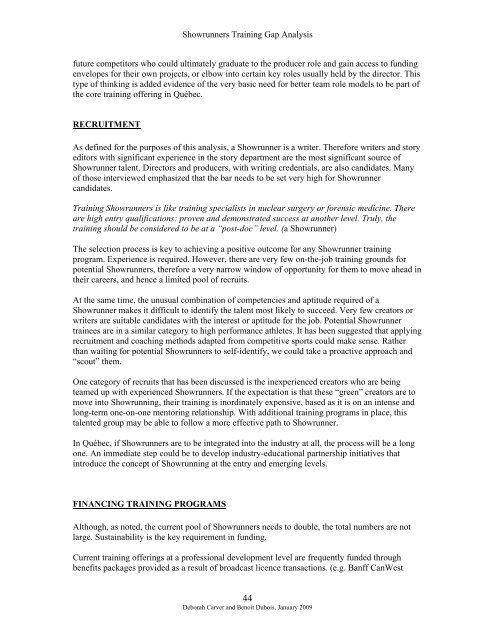Showrunners - Training Gaps Analysis - Cultural Human Resources ...
Showrunners - Training Gaps Analysis - Cultural Human Resources ...
Showrunners - Training Gaps Analysis - Cultural Human Resources ...
Create successful ePaper yourself
Turn your PDF publications into a flip-book with our unique Google optimized e-Paper software.
<strong>Showrunners</strong> <strong>Training</strong> Gap <strong>Analysis</strong><br />
future competitors who could ultimately graduate to the producer role and gain access to funding<br />
envelopes for their own projects, or elbow into certain key roles usually held by the director. This<br />
type of thinking is added evidence of the very basic need for better team role models to be part of<br />
the core training offering in Québec.<br />
RECRUITMENT<br />
As defined for the purposes of this analysis, a Showrunner is a writer. Therefore writers and story<br />
editors with significant experience in the story department are the most significant source of<br />
Showrunner talent. Directors and producers, with writing credentials, are also candidates. Many<br />
of those interviewed emphasized that the bar needs to be set very high for Showrunner<br />
candidates.<br />
<strong>Training</strong> <strong>Showrunners</strong> is like training specialists in nuclear surgery or forensic medicine. There<br />
are high entry qualifications: proven and demonstrated success at another level. Truly, the<br />
training should be considered to be at a “post-doc” level. (a Showrunner)<br />
The selection process is key to achieving a positive outcome for any Showrunner training<br />
program. Experience is required. However, there are very few on-the-job training grounds for<br />
potential <strong>Showrunners</strong>, therefore a very narrow window of opportunity for them to move ahead in<br />
their careers, and hence a limited pool of recruits.<br />
At the same time, the unusual combination of competencies and aptitude required of a<br />
Showrunner makes it difficult to identify the talent most likely to succeed. Very few creators or<br />
writers are suitable candidates with the interest or aptitude for the job. Potential Showrunner<br />
trainees are in a similar category to high performance athletes. It has been suggested that applying<br />
recruitment and coaching methods adapted from competitive sports could make sense. Rather<br />
than waiting for potential <strong>Showrunners</strong> to self-identify, we could take a proactive approach and<br />
“scout” them.<br />
One category of recruits that has been discussed is the inexperienced creators who are being<br />
teamed up with experienced <strong>Showrunners</strong>. If the expectation is that these “green” creators are to<br />
move into Showrunning, their training is inordinately expensive, based as it is on an intense and<br />
long-term one-on-one mentoring relationship. With additional training programs in place, this<br />
talented group may be able to follow a more effective path to Showrunner.<br />
In Québec, if <strong>Showrunners</strong> are to be integrated into the industry at all, the process will be a long<br />
one. An immediate step could be to develop industry-educational partnership initiatives that<br />
introduce the concept of Showrunning at the entry and emerging levels.<br />
FINANCING TRAINING PROGRAMS<br />
Although, as noted, the current pool of <strong>Showrunners</strong> needs to double, the total numbers are not<br />
large. Sustainability is the key requirement in funding.<br />
Current training offerings at a professional development level are frequently funded through<br />
benefits packages provided as a result of broadcast licence transactions. (e.g. Banff CanWest<br />
44<br />
Deborah Carver and Benoit Dubois, January 2009










